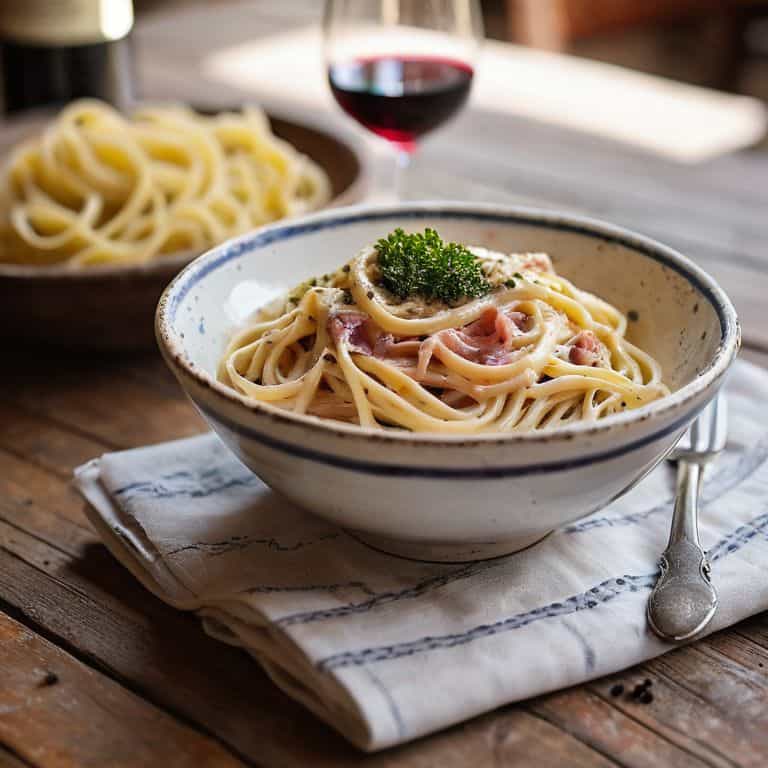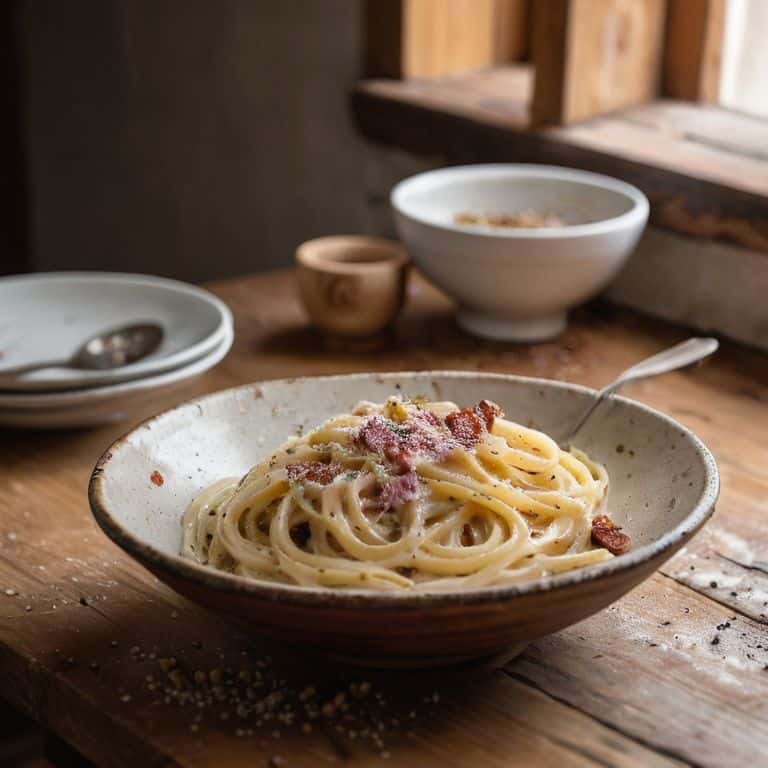I still remember the first time I tried to make authentic carbonara in my tiny kitchen in Rome. I was a young journalist, eager to impress my Italian friends with my cooking skills, but my dish was a far cry from the creamy, rich pasta I had fallen in love with at the local trattorias. The problem was, I had been following all the wrong recipes, loading my carbonara with heavy cream and bacon – a common mistake that would make any Italian nonna shake her head. But then, I met Giovanni, a gruff but kind Roman chef who took me under his wing and taught me the secrets of a true carbonara, and I learned that the key to how to make authentic carbonara lies in its simplicity.
As I share my story and recipe with you, I promise to cut through the noise and give you the honest truth about this beloved Italian dish. I’ll show you how to make a carbonara that’s true to its roots, using only the finest ingredients and techniques passed down through generations of Italian cooks. My goal is to empower you to create a dish that’s not only delicious but also respectful of the traditions that have made carbonara a staple of Italian cuisine. So, if you’re ready to leave the cream and bacon behind and learn how to make authentic carbonara, join me on this culinary journey, and let’s get started!
Table of Contents
Recipe Details
Ingredients
- 12 oz spaghetti
- 4 oz guanciale or pancetta (diced)
- 3 large eggs
- 1 cup grated Parmigiano-Reggiano cheese (freshly grated)
- Salt (to taste)
- Black pepper (freshly ground)
Tools & Supplies
- Large pot
- Colander
- Cutting board
- Knife
- Whisk
- Large serving bowl
Recipe Instructions
Step 1
First, let’s start with the essential ingredients for an authentic Italian carbonara: guanciale, eggs, parmesan cheese, and black pepper. I remember my Nonna used to say that the quality of these ingredients is what makes or breaks the dish, so don’t even think about using that bacon from the supermarket – it’s all about the cured pork jowl for that authentic flavor.
Step 2
Next, bring a large pot of salted water to a boil and cook your spaghetti according to the package instructions until it’s al dente. Now, I know what you’re thinking – “Why not use a fancy pasta shape?” But trust me, the traditional spaghetti is the way to go here, as it allows the carbonara sauce to coat each strand perfectly.
Step 3
While your pasta is cooking, it’s time to prepare the guanciale. Cut it into small strips and cook it in a pan over medium heat until it’s crispy. This is where the magic happens, folks – the rendered fat from the guanciale is what gives the carbonara its rich, creamy flavor. Remove the cooked guanciale from the pan with a slotted spoon and set it aside on a paper towel-lined plate.
Step 4
In a large bowl, whisk together fresh eggs, parmesan cheese, and a generous amount of black pepper. I like to use room temperature eggs for this, as it helps the mixture come together more smoothly. Now, add the cooked guanciale to the bowl and toss everything together until the guanciale is evenly distributed – this is where the flavors start to meld.
Step 5
Once your spaghetti is done cooking, drain it and add it to the bowl with the egg mixture. Toss everything together until the spaghetti is well coated with the carbonara sauce. The key here is to work quickly, as you want to trap the heat from the pasta to cook the eggs slightly and create that creamy texture. Season with a bit more black pepper to taste, and you’re ready to serve up a dish that’s sure to transport your taste buds straight to the streets of Rome.
Unlocking Authentic Carbonara

As I delved deeper into the world of traditional Italian pasta dishes, I discovered that carbonara without cream is the only way to go. It’s a common mistake to add cream, but trust me, it’s a game-changer to stick with the original recipe. I recall a conversation with a Roman nonna who swore by the simplicity of guanciale, eggs, and parmesan. She would often say, “il segreto è nella qualità degli ingredienti,” which translates to “the secret is in the quality of the ingredients.”
When it comes to choosing between guanciale and pancetta, I always opt for guanciale vs pancetta. The difference may seem subtle, but it makes all the difference in the flavor profile. Guanciale has a more delicate, unsmoked flavor that pairs perfectly with the egg yolk sauce. To achieve perfectly cooked spaghetti, it’s essential to cook it al dente, then toss it with the egg yolk sauce while it’s still warm. This helps the sauce coat the pasta evenly, creating a rich and creamy texture.
In the heart of Roman cuisine specialties lies the art of creating a beautiful egg yolk sauce. It’s all about tempering the eggs with the pasta water to create a smooth, velvety texture. Egg yolk sauce techniques require patience and practice, but the end result is well worth the effort. By mastering this technique, you’ll be able to create a truly authentic carbonara that will transport your taste buds to the cobblestone streets of Rome.
Egg Yolk Sauce Techniques for Creamless Perfection
The egg yolk sauce – the crowning glory of a true carbonara. I recall a sunny afternoon in Rome, watching Nonna whip up this emulsion with ease. She’d crack in the egg yolks, then slowly pour in the hot pasta water, whisking furiously as the mixture transformed into a silky, golden sauce. The key, she’d say, is tempering – gently warming the yolks to prevent them from scrambling. By doing so, you create a creamy, yet surprisingly creamless, sauce that coats the pasta with elegance.
To achieve this perfection, I’ve found that using room temperature egg yolks is crucial, as is adding the pasta water in a thin, steady stream. Whisk constantly, feeling the sauce thicken and emulsify, until you reach that sublime, velvety texture. It’s a technique that requires patience and a gentle touch, but trust me, the result is well worth the practice.
Guanciale vs Pancetta the Roman Choice
As I wandered through the Roman markets, I discovered the essence of authentic carbonara lies in the cured meats. Guanciale, with its unsmoked, delicate flavor, is the preferred choice of Roman nonnas. Pancetta, while similar, has a stronger, smokier taste that can overpower the dish. I recall a lively debate with a local butcher, who passionately argued that guanciale’s subtle sweetness is what makes carbonara truly Roman. He handed me a slice, and as I savored it, I knew he was right.
In my kitchen, I’ve come to appreciate the difference guanciale makes. Its creamy, velvety texture melts beautifully into the eggs and parmesan, creating a rich, indulgent sauce. While pancetta can be a decent substitute, it’s the guanciale that adds a depth of flavor that’s unmistakably Italian. For an authentic carbonara experience, I highly recommend seeking out this Roman delicacy – your taste buds will thank you.
Bringing Roma to Your Table: 5 Essential Tips for Authentic Carbonara

- Use guanciale over pancetta or bacon for an unmistakably Roman flavor, as it provides a more delicate, unsmoked taste that elevates the dish
- Fresh eggs are paramount; ensure they are at room temperature to facilitate a smoother egg yolk sauce, which is crucial for a creamless yet velvety carbonara
- Grate your parmesan cheese fresh; pre-grated cheese can be too fine and lacks the depth of flavor that a freshly grated, high-quality parmesan provides
- Avoid overcooking your spaghetti; al dente is key to maintaining texture and ensuring your carbonara isn’t a mushy, unpleasant experience
- Whisk your egg yolks with a fork, not a whisk, and temper them gently with the pasta heat to prevent scrambling, achieving a silky, sauce-like consistency
Bringing Home the Flavors of Italy: 3 Key Takeaways
Guanciale is the unsung hero of authentic carbonara, offering a depth of flavor that pancetta and bacon simply can’t match, so don’t be afraid to seek it out for the true Roman experience
Egg yolk sauce is the secret to a creamless yet indulgent carbonara – mastering the technique of tempering eggs with hot pasta water is crucial for a silky, authentic finish
By keeping it simple with just a few, high-quality ingredients and honoring the traditions of Italian nonnas, you can create a carbonara that transports you straight to the cobblestone streets of Rome, no matter where you are in the world
The Heart of Carbonara
A true carbonara is not just about the ingredients, but about the story of the people who taught me how to crack the eggs, cure the guanciale, and whisper the secrets of Rome’s culinary soul.
Marco Bianchi
Savoring the Flavors of Italy

As I reflect on my journey to create the authentic carbonara of my Roman childhood, I’m reminded of the importance of tradition in Italian cuisine. From the careful selection of guanciale over pancetta to the delicate technique of crafting an egg yolk sauce without cream, each element is a testament to the simplicity and elegance of authentic Italian cooking. By following the recipe and steps outlined in this article, you’ll be well on your way to unlocking the secrets of a truly authentic carbonara, just like Nonna used to make.
As you sit down to enjoy your homemade carbonara, I hope you’ll remember that the true beauty of this dish lies not just in its rich flavors, but in the stories and traditions it represents. So go ahead, take a bite, and let the tastes of Italy transport you to a small trattoria in Rome, where the pasta is always al dente, the company is always warm, and the carbonara is always made with love.
Frequently Asked Questions
What's the best way to cook guanciale for an authentic carbonara without making it too crispy?
My friend, cooking guanciale for carbonara is an art. I learned from a Roman nonna to slice it thin, then cook it over low heat, stirring often, until it’s tender and slightly crispy. This way, it retains its silky texture and deep flavor, perfect for coating your pasta. Trust me, it’s worth the gentle approach.
Can I substitute Parmesan with other types of cheese and still achieve an authentic Italian flavor?
My friend, while I understand the temptation, substituting Parmesan with other cheeses just won’t cut it for authentic carbonara. The nutty, salty flavor of Parmigiano-Reggiano is unmistakable. You can try other hard cheeses like Pecorino, but it’s just not the same. Trust me, I’ve learned from the Roman nonnas – Parmesan is the heart of carbonara.
How do I prevent the egg yolks from scrambling when I add them to the hot pasta for a creamy sauce?
My friend, the key is to temper those egg yolks first! Whisk them with a bit of pasta water, then slowly pour the warm water into the eggs, whisking constantly. This gentle heat introduction will save your sauce from scrambled disaster, ensuring a silky, creamy carbonara just like Nonna’s.
